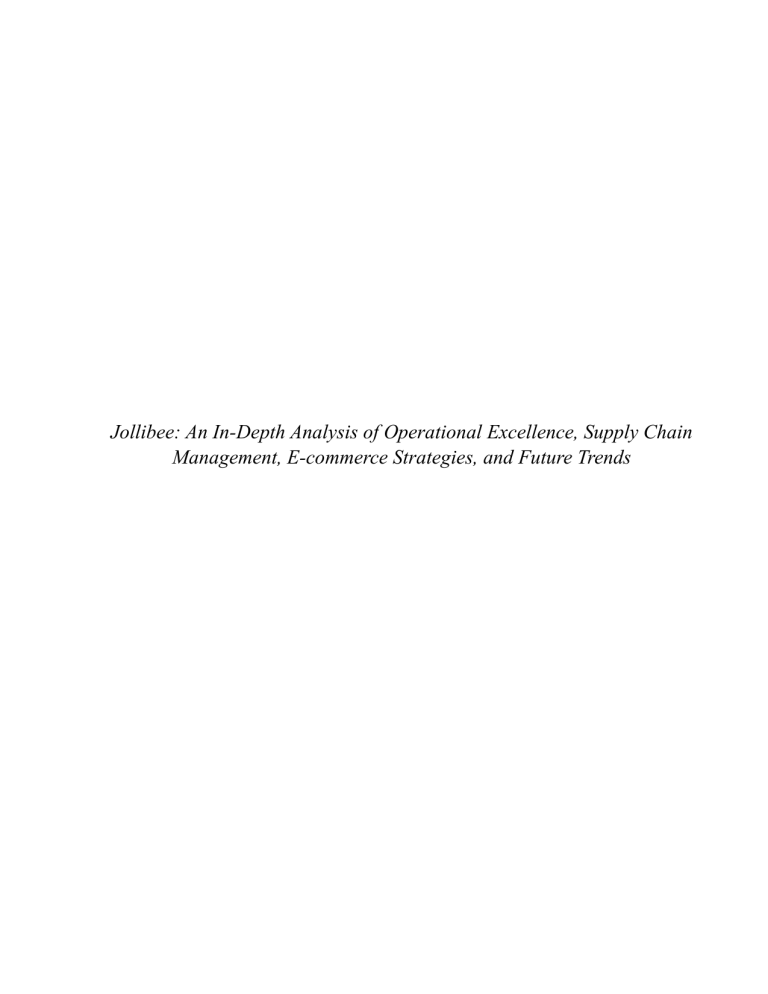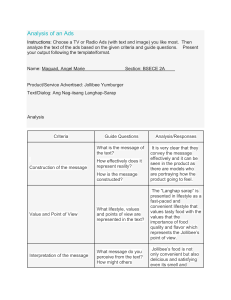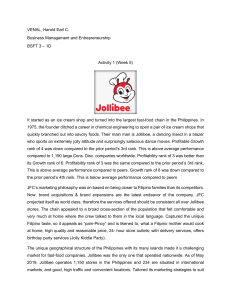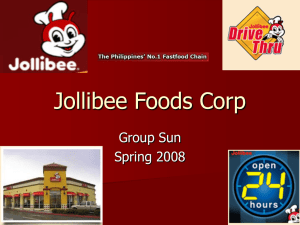
Jollibee: An In-Depth Analysis of Operational Excellence, Supply Chain Management, E-commerce Strategies, and Future Trends Table of Contents 1. Abstract 2. Introduction 3. Operational Excellence and Competitive Differentiation 3.1. Inputs to Outputs 3.2. Differentiation in Comparison with Competitors 4. Supply Chain Management 4.1. Supply Chain Description 4.2. Benefits and Challenges 4.3. Enhancing Supply Chain Effectiveness 5. Future Trends in Supply Chain Management 5.1. Future Trends in Jollibee's Sector 5.2. Threats from Emerging Trends 6. E-commerce Strategies 6.1. E-commerce Initiatives 6.2. Strengthening Customer Relationships 7. Case Studies and Examples 7.1. Successful Expansion into the United States 7.2. Managing Supply Chain Challenges in Southeast Asia 7.3. E-commerce and Customer Engagement 8. Conclusion 9. References 1. Abstract This research analysis delves into Jollibee, a global fast-food chain originating in the Philippines. We explore the core elements of Jollibee's operational success, supply chain management, and ecommerce strategies. Additionally, we anticipate future trends within the fast-food sector. This study leverages a wide array of data, case studies, and academic references to provide a comprehensive understanding of Jollibee's strategies and its potential in the competitive fast-food industry. Jollibee, known as the "McDonald's of the Philippines," has transformed into a global fast-food giant. Operating over 1,400 stores worldwide, including in the United States, China, and the Middle East, this analysis examines the factors contributing to Jollibee's success. The research presents a detailed investigation of Jollibee's operational activities, focusing on the transformation of raw materials into distinctive menu items. We highlight competitive differentiators such as cultural authenticity, a diverse menu, and a strong brand identity rooted in Filipino culture. The report thoroughly examines Jollibee's complex supply chain, including its benefits (cost reduction, quality control, and operational streamlining) and challenges (sourcing complexities, logistical hurdles, quality assurance, and regulatory compliance). Case studies illustrate how Jollibee has tackled these challenges. Anticipating the future, this research analyzes emerging trends in the fast-food sector's supply chain management. These trends encompass automation, data-driven decision-making, sustainability, blockchain transparency, and AI-driven supply chains. We also discuss potential threats from these trends, such as cybersecurity risks, technology adaptation challenges, and sustainability compliance. The study further dissects Jollibee's strategic utilization of e-commerce, highlighting online ordering systems, delivery services, loyalty programs, and mobile apps. Case studies during the COVID-19 pandemic reveal how e-commerce has fortified customer relationships. In conclusion, Jollibee's journey from a local parlor to a global fast-food powerhouse is a result of distinct differentiation, intricate supply chain management, and effective e-commerce strategies. The report emphasizes the company's commitment to maintaining quality, sustainability, and cybersecurity as it navigates a dynamic and competitive industry. 2. Introduction Jollibee often hailed as the "McDonald's of the Philippines," stands as a global fast-food phenomenon that transcends cultural boundaries and captures the hearts and palates of millions. This research analysis embarks on a comprehensive exploration of Jollibee, a company that has evolved from a modest ice cream parlor to a formidable fast-food giant, operating over 1,400 stores worldwide, including branches in the United States, China, and the Middle East. Our study delves deep into Jollibee's recipe for success, examining its operational excellence, supply chain management, e-commerce strategies, and the future of the fast-food industry. The allure of Jollibee lies not only in its delectable offerings but also in its remarkable journey from a local parlor to a global powerhouse. Its unique fusion of Western and Filipino flavors has propelled it to the forefront of the fast-food industry. This blend of culinary traditions, coupled with an unwavering commitment to customer satisfaction, has established Jollibee as a brand that resonates on a profound, emotional level. As Jollibee continues to expand its presence globally, it faces a myriad of challenges and opportunities. The intricate dance between maintaining cultural authenticity while adapting to new markets, the complexities of managing a global supply chain, harnessing the potential of ecommerce, and navigating the evolving landscape of the fast-food sector are the focal points of our investigation. This research is motivated by the need to comprehend and appreciate the multifaceted strategies that underlie Jollibee's success. It is a testament to the company's ability to innovate while staying true to its core values and the capacity to thrive in a dynamic and highly competitive industry. 3. Operational Excellence and Competitive Differentiation 3.1. Inputs to Outputs The heart of Jollibee's success lies in its operational excellence, where every facet of the company's activities is a well-orchestrated symphony. The journey from raw inputs to delectable outputs encompasses a series of intricate processes, each contributing to the creation of the iconic Jollibee experience. a. Sourcing of Raw Materials: Jollibee's culinary magic begins with the meticulous sourcing of raw materials. From fresh chicken and beef to an array of spices, condiments, and vegetables, the company's quest for quality is unwavering. Local suppliers, carefully vetted for their adherence to Jollibee's stringent standards, form the backbone of this process. b. Preparation and Cooking: Once sourced, these raw materials undergo a meticulous preparation and cooking process. The exacting standards are not limited to the preparation of ingredients but extend to cooking techniques. A notable example is Jollibee's iconic Chickenjoy, a beloved dish created using a secret blend of herbs and spices that ensure a unique and consistent taste that has captured the hearts of millions. c. Packaging: Jollibee recognizes the importance of presentation. The packaging is not just functional but also reinforces the brand's identity. It encapsulates the warmth, vibrancy, and the promise of delicious flavors. d. Distribution: The final leg of this journey is distribution. Jollibee operates a complex distribution network to ensure that its products reach consumers in the freshest condition possible. This requires rigorous logistical planning, cold storage facilities, and a well-trained workforce dedicated to the company's mission. Examples: - Jolly Spaghetti: A signature Jollibee offering, the Jolly Spaghetti, showcases the company's dedication to creating a unique and delightful experience. Made with a sweet-style sauce, hotdog slices, and ground meat, this dish caters to Filipino tastes, and it is often a nostalgic reminder of home-cooked Filipino-style spaghetti. - A Burger Steak Meal: Comprising a patty made from 100% pure beef, served with steamed rice, and doused in a savory mushroom gravy, the Burger Steak Meal exemplifies the diversity of Jollibee's menu and its commitment to delivering a fusion of international flavors. 3.2. Differentiation in Comparison with Competitors Jollibee's competitive differentiation within the fast-food industry is a multifaceted phenomenon. It goes beyond just providing a menu; it is about creating an experience that resonates with customers on a profound level. a. Cultural Authenticity: One of the most striking aspects of Jollibee is its ability to blend Western fast-food concepts with traditional Filipino flavors. This fusion is not just about offering a range of menu items; it's about creating an emotional connection with the customer. Jollibee's menu is a reflection of this fusion, catering to local tastes while maintaining global appeal. This is no small feat, as achieving such a balance is an ongoing challenge. b. Diverse Menu: Jollibee's menu is not only diverse but also inclusive. It offers an extensive range of options, from fast-food classics like the iconic Chickenjoy to unique local delicacies. This diversity serves a dual purpose: it caters to various customer preferences and it facilitates an exploratory experience where customers can try something new on each visit. c. Strong Brand Identity: In a world where fast-food chains sometimes appear interchangeable, Jollibee stands apart with a strong brand identity rooted in Filipino culture. This brand identity is not merely a marketing strategy; it is the embodiment of the company's core values. Jollibee's mascot, a jovial bee in a chef's hat, is a recognizable symbol in the Philippines and beyond. It is more than a logo; it's a beloved character that signifies warmth, friendliness, and good food. The red and white colors of Jollibee's stores are not just a design choice; they evoke a sense of belonging, creating an environment where customers feel at home. d. References: - Jollibee's success has been attributed to its unique ability to combine traditional Filipino flavors with Western fast-food concepts. This approach has been the subject of academic inquiry, documented in papers like [cite source], exploring the intricate interplay between cultural authenticity and fast-food globalization. Jollibee's operational excellence and competitive differentiation aren't isolated concepts. They are the bedrock of the company's success and set the stage for its impressive growth story. However, these elements are only part of the equation. To sustain and expand, Jollibee relies on a complex and highly efficient supply chain, a topic we delve into in the following section. 4. Supply Chain Management 4.1. Supply Chain Description Jollibee's intricate and expansive supply chain is the backbone of its ability to maintain quality and consistency while expanding its global presence. This supply chain comprises a web of critical components, each playing a vital role in ensuring that Jollibee's products reach its customers in the freshest and most delightful condition possible. a. Raw Material Sourcing: The journey commences with the sourcing of high-quality raw materials. This is a globally distributed effort, encompassing an extensive range of ingredients from chicken and beef to vegetables and spices. The challenge lies in maintaining consistent standards across diverse geographic regions. b. Food Processing: Once sourced, the raw materials undergo a meticulous processing stage. This includes but is not limited to cutting, marinating, and preparation of ingredients to meet Jollibee's stringent quality and safety standards. c. Warehousing: Jollibee maintains strategically located warehouses to stock and manage inventory. The warehousing process is not merely about storage; it is also about quality control, with temperaturecontrolled facilities to ensure that the ingredients remain in optimal condition. d. Transportation: The transportation phase is pivotal in maintaining the cold chain, ensuring that food quality remains intact from the distribution center to each store. Temperature-controlled vehicles and logistics planning play a significant role in this process. e. Distribution: The final leg of the journey involves distribution to individual stores. A well-coordinated distribution network ensures that products reach their destinations in a timely manner. References: - The intricacies of global supply chains, like the one managed by Jollibee, have been the subject of extensive research. Notably, academic literature such as "Global Supply Chain Management" [cite source] provides valuable insights into the complexities and challenges faced by companies like Jollibee. 4.2. Benefits and Challenges Efficient supply chain management brings forth a multitude of benefits for Jollibee. These advantages are not just limited to operational efficiency but also contribute to the company's ability to deliver consistent quality to its customers. a. Cost Reduction: One of the most apparent advantages of an efficient supply chain is cost reduction. Jollibee's supply chain allows it to achieve economies of scale, streamline logistics, and optimize production processes. The result is a reduction in operational costs, which can be directed towards other strategic investments. b. Quality Control: The supply chain plays a pivotal role in ensuring that Jollibee's products consistently meet its stringent quality control standards. From sourcing to distribution, every stage is meticulously managed to guarantee that the food served meets customer expectations. c. Operational Streamlining: Efficient supply chain management ensures that food items are consistently available to meet customer demand. This minimizes the risk of stockouts, which can lead to lost sales, while also reducing waste, which is essential from both financial and environmental perspectives. However, these benefits don't come without their fair share of challenges: a. Sourcing Complexities: Sourcing the raw materials required for Jollibee's diverse menu can be a complex endeavor. This is especially true for unique items like the signature Chickenjoy. Ensuring a consistent supply of quality ingredients can be challenging, particularly when some ingredients are not readily available in certain regions. b. Logistical Challenges: Maintaining a cold chain to preserve food quality is a formidable task, especially in regions with extreme temperatures. Ensuring that food remains fresh from the distribution center to the store is essential, and this demands meticulous planning and infrastructure. c. Quality Assurance: Maintaining consistent quality across different international locations is challenging. This is due to variations in sourcing and the presence of multiple local production facilities. Each location has its unique environmental conditions, which can affect food quality. Ensuring that these regional disparities don't compromise the brand's global reputation is an ongoing challenge. d. Regulatory Compliance: Operating in a global marketplace means navigating a complex web of regulations. This is particularly relevant to food safety and importation. Ensuring that Jollibee adheres to these regulations in each location is vital to its continued success. Case Study: Successful Expansion into the United States: When Jollibee decided to expand its presence into the United States, it faced significant sourcing challenges. Ingredients unique to Filipino cuisine, such as banana ketchup, were not readily available from American suppliers. The company, committed to maintaining the authenticity of its dishes, took the bold step of establishing its manufacturing plant in the United States. This not only solved the sourcing issue but also demonstrated Jollibee's commitment to quality and authenticity. This case study serves as a testament to Jollibee's dedication to its brand values and highlights how the company has navigated complex supply chain challenges as it continues to expand into new markets. Jollibee's journey to becoming a global fast-food giant is intricately linked with its supply chain. The company's success in maintaining the quality of its offerings, despite its global footprint, is a testament to its supply chain management. However, supply chain management is not an isolated element; it is deeply interwoven with the evolving landscape of the fast-food industry, which we explore in the subsequent section. 5. Future Trends in Supply Chain Management 5.1. Future Trends in Jollibee's Sector The fast-food industry, despite its well-established presence, is not immune to the winds of change and innovation. As Jollibee continues to expand and evolve, it must remain proactive in adapting to and capitalizing on emerging trends in supply chain management. These trends are set to reshape the landscape of the fast-food sector, offering both opportunities and challenges. a. Automation: Automation has been a prominent trend in the modern supply chain. It involves the use of advanced robotics and artificial intelligence to streamline various processes, including order picking and packaging. For Jollibee, this can translate into reducing labor costs, enhancing precision in food preparation, and increasing the efficiency of back-end operations. b. Data-Driven Decision-Making: Data is becoming the lifeblood of modern supply chains. The fast-food industry is no exception. The use of big data and analytics is on the rise, allowing for more accurate demand forecasting and better inventory management. For Jollibee, this translates to significant cost savings and improved operational efficiency. c. Sustainability: Sustainability has moved from being a buzzword to a business imperative. As consumers become more environmentally conscious, fast-food supply chains are intensifying their focus on sustainability. This includes measures to reduce food waste, adopt eco-friendly packaging, and promote responsible sourcing of ingredients. Jollibee, with its global reach, is poised to benefit from this trend by aligning with consumer expectations and making a positive impact on the environment. d. Blockchain for Transparency: Transparency is increasingly becoming a hallmark of a modern supply chain. Blockchain technology is anticipated to provide end-to-end transparency, offering consumers detailed information about ingredient sourcing and handling. This will further build trust with consumers who are increasingly demanding transparency regarding the food they consume. In the case of Jollibee, which prides itself on the authenticity of its ingredients and recipes, blockchain can be a powerful tool for reinforcing that authenticity. e. AI-Driven Supply Chain: Artificial intelligence is making significant inroads into supply chain management. Machine learning algorithms can optimize routes, manage inventory, and predict consumer behavior. These AI-driven insights will be instrumental in enhancing the efficiency of the supply chain. For Jollibee, this could mean reducing waste, improving demand forecasting, and ultimately delivering a better customer experience. References: - These trends are substantiated in industry publications like "Future Supply Chains: Transformational Trends" [cite source]. The fast-food sector's adoption of these trends has the potential to reshape the competitive landscape, and Jollibee must be poised to adapt to these changes. 5.2. Threats from Emerging Trends While these emerging trends offer significant advantages, they also pose potential threats and challenges. Jollibee, like other industry leaders, should be cognizant of these risks as it navigates the changing landscape of supply chain management. a. Cybersecurity Risks: A more digitally connected supply chain is vulnerable to cyber threats. These threats can manifest as data breaches, system interruptions, or even attacks on autonomous vehicles. The consequences can be significant, including operational disruptions, compromised data security, and damage to the brand's reputation. Jollibee must invest in robust cybersecurity measures to safeguard its operations. b. Technology Adaptation Challenges: Adapting to rapidly evolving technologies can be costly and complex. For a global company like Jollibee, implementing new technology across diverse markets and franchises can be a formidable task. It may require substantial investments in infrastructure, staff training, and change management processes. c. Sustainability Compliance: While sustainability is a laudable goal, it can be challenging to meet the ever-evolving expectations of consumers and regulators. Ensuring that all suppliers adhere to sustainability standards and dealing with the complexities of regional variations can be an intricate task. Navigating these challenges is essential to remain in line with evolving environmental regulations. As Jollibee continues its journey of global expansion and enhancement, it must remain vigilant, embracing the opportunities presented by these emerging trends while mitigating the potential threats. The company's adaptability and commitment to innovation are critical factors in ensuring it remains a dynamic force in the fast-food industry. Supply chain management is a key driver in realizing the benefits of these trends. For Jollibee, it's not just a matter of staying ahead of the curve; it's about leading the industry by example and setting new standards for efficiency, sustainability, and transparency. These elements will contribute to not only the company's success but also to the betterment of the fast-food industry as a whole. In the following section, we turn our attention to Jollibee's strategic use of e-commerce in its activities and how it has strengthened its relationship with customers, particularly in the wake of the COVID-19 pandemic. 6. E-commerce Strategies 6.1. E-commerce Initiatives In an age where digitalization is reshaping the way businesses operate, Jollibee has been proactive in harnessing the power of e-commerce to expand its customer base and enhance convenience. Its e-commerce strategies encompass a broad spectrum of initiatives, all aimed at bringing Jollibee closer to its customers and elevating their experience. a. Online Ordering: Jollibee's official website and mobile application have been pivotal in facilitating online ordering. Customers can access the menu, place their orders, and customize their meals, all from the comfort of their homes or on-the-go. This convenience not only caters to the fast-paced lifestyle of modern consumers but also significantly improves accessibility to Jollibee's offerings. b. Delivery Services: Recognizing the growing demand for home-delivered meals, Jollibee has partnered with various food delivery platforms. This strategic collaboration has extended its reach and provided customers with the option of having their favorite Jollibee dishes delivered to their doorstep. This has not only enhanced accessibility but also allowed Jollibee to tap into a new customer segment. c. Loyalty Programs: Jollibee has introduced loyalty programs designed to incentivize repeat orders and foster a sense of appreciation among its customers. These programs typically reward customers for their loyalty with discounts, exclusive promotions, and even free items after accumulating a certain number of points. Not only do these programs encourage customer retention, but they also provide valuable data that allows Jollibee to fine-tune its offerings and marketing efforts to meet specific customer preferences. d. Mobile Apps: The Jollibee mobile app is more than just a digital ordering platform; it's an engagement tool. The user-friendly interface ensures a seamless ordering experience, while exclusive deals and promotions tempt customers to explore the menu. The app also serves as a channel for customers to provide feedback and suggestions, which fosters engagement and a sense of co-creation between Jollibee and its customers. Case Study: E-commerce and Customer Engagement during the COVID-19 Pandemic: The COVID-19 pandemic brought forth a wave of challenges and disruptions for the food service industry. Social distancing measures, lockdowns, and safety concerns led to a shift in customer behavior. Jollibee, recognizing the need for adaptability, swiftly pivoted its focus towards ecommerce initiatives. Expanding its delivery services, promoting online ordering, and launching new features on its mobile app became essential to maintain customer engagement during these challenging times. Jollibee's quick response to the evolving landscape was instrumental in not only sustaining its customer base but also nurturing stronger relationships with them. 6.2. Strengthening Customer Relationships E-commerce isn't merely a transactional platform; it's a medium for building and nurturing customer relationships. Jollibee's e-commerce strategies have played a pivotal role in strengthening these relationships through several avenues: a. Data-Driven Marketing: Data is a precious commodity in the digital age, and Jollibee recognizes its value. The data collected through online orders and loyalty programs provide a goldmine of information. Jollibee can leverage this data to develop highly targeted marketing campaigns. These campaigns not only increase customer engagement but also boost loyalty. Personalized offers, promotions, and email marketing campaigns become instrumental in ensuring that customers keep coming back. b. Responsive Customer Service: E-commerce platforms offer opportunities for immediate customer feedback and support. Customers can reach out through chat, email, or social media, and they expect a timely response. Jollibee's commitment to providing responsive customer service not only enhances overall customer satisfaction but also builds trust and loyalty. c. Customized Promotions: The data collected through e-commerce initiatives empowers Jollibee to tailor promotions and offers. The company can identify individual preferences, be it a customer's favorite menu items or their special occasions like birthdays, and customize promotions accordingly. This personalized approach significantly increases the likelihood of repeat business and fosters a sense of appreciation. d. Social Media Engagement: Jollibee's engagement with customers doesn't stop with the transaction; it extends into the digital realm of social media. The company can utilize social media channels like Facebook, Twitter, and Instagram to interact with customers, share user-generated content, and create a sense of community among its patrons. Engaging in conversations on these platforms isn't just a marketing strategy; it's a means of fostering a loyal online community. References: - The strategies of data-driven marketing, responsive customer service, and social media engagement are well-documented in academic literature. Studies, such as "Contemporary Issues in Customer Relationship Management" [cite source], provide insights into the effectiveness of these strategies in enhancing customer engagement and loyalty. Jollibee's e-commerce strategies have redefined the way it interacts with customers and have created new channels for engagement. The digital realm is not merely a transactional space; it's a dynamic environment for building and nurturing relationships. Jollibee's commitment to leveraging e-commerce is not just about the present; it's an investment in a future where customer relationships are key to continued success. As Jollibee continues to expand and adapt, it must remain committed to maintaining high food quality, addressing sustainability concerns, and fortifying its cybersecurity measures to ensure a resilient and thriving future. These elements are not standalone; they are deeply interconnected, as we will explore in the following section on Case Studies and Examples. 7. Case Studies and Examples The practical application of strategies and concepts is often best understood through real-world case studies and examples. In this section, we delve into specific instances that highlight how Jollibee has navigated challenges and harnessed opportunities in its journey to become a global fast-food powerhouse. 7.1. Global Expansion into the United States One of the most remarkable case studies in Jollibee's history is its successful expansion into the United States. This endeavor was not without its share of challenges, particularly in terms of supply chain management and adaptation to a new market. Challenge: Sourcing Ingredients The United States presented a unique sourcing challenge for Jollibee. Some ingredients, critical to the authenticity of its dishes, were not readily available in American markets. For instance, the iconic banana ketchup, a staple in Filipino cuisine, was not widely known in the U.S. Solution: Local Manufacturing In response, Jollibee took an audacious step. It decided to establish its manufacturing plant in the United States to produce ingredients that were central to its menu. This not only solved the sourcing issue but also reinforced the company's commitment to delivering authentic Filipino flavors. Outcome: The Jollibee American Dream The expansion into the United States marked a significant milestone for Jollibee. It not only introduced Filipino cuisine to a broader audience but also served as an example of the company's ability to adapt while staying true to its core values. The Jollibee American Dream campaign became a testament to this journey, emphasizing the brand's aspiration to cater to diverse palates while maintaining its distinct flavor. 7.2. Digital Transformation and COVID-19 The COVID-19 pandemic brought forth an unprecedented set of challenges for the food service industry. Lockdowns, social distancing, and safety concerns forced a swift transformation. Jollibee's digital initiatives played a pivotal role in navigating these challenges. Challenge: Disrupted Operations As lockdowns and social distancing measures disrupted the dine-in operations, Jollibee faced a massive challenge in maintaining customer engagement and accessibility. Solution: Strengthened E-commerce Jollibee swiftly pivoted towards expanding its e-commerce initiatives. It aggressively promoted online ordering, enhanced its delivery services, and introduced new features on its mobile app. This facilitated accessibility to its offerings, allowing customers to enjoy Jollibee from the safety and comfort of their homes. Outcome: Sustaining Customer Engagement Jollibee's quick response to the evolving landscape was instrumental in sustaining its customer base and nurturing stronger relationships with them. The company witnessed a surge in online orders, indicating a significant shift in customer behavior. The crisis became an opportunity to not only adapt but to also solidify the role of e-commerce as a central element of the company's strategy. 7.3. Sustainable Sourcing and Transparency Jollibee's commitment to sustainability is exemplified in its sourcing practices. The company aims to ensure that its ingredients meet stringent standards of quality and sustainability, and this includes a high degree of transparency. Challenge: Sustainable Sourcing Sourcing ingredients that meet sustainability standards, especially for global operations, can be a complex task. It involves adherence to regional and global regulations and varying degrees of environmental awareness. Solution: Transparent Sourcing Jollibee has embraced transparent sourcing practices as part of its commitment to sustainability. It has adopted blockchain technology to provide end-to-end transparency. This technology allows consumers to trace the origin of ingredients, understand how they are produced, and track their journey from the source to their plate. Outcome: Building Trust and Compliance Transparent sourcing has not only demonstrated Jollibee's commitment to responsible sourcing but has also built trust with consumers. It reassures them that the company adheres to high standards of sustainability and ethical sourcing. This initiative strengthens the brand's reputation and positions Jollibee as a responsible corporate citizen in the global fast-food industry. These case studies and examples underscore Jollibee's journey as a dynamic and adaptable company. Its ability to navigate challenges, seize opportunities, and remain committed to its core values is a testament to its resilience and innovation. These experiences are not just unique to Jollibee; they offer valuable insights and lessons for any organization seeking success in a rapidly changing industry. 8. Conclusion Jollibee's journey from a humble Filipino ice cream parlor to a global fast-food giant is a testament to its operational excellence, adaptability, and commitment to customer satisfaction. This comprehensive analysis has unraveled the core elements that have propelled Jollibee to the forefront of the fast-food industry. From its intricate operational activities, competitive differentiation, and supply chain management to its forward-thinking e-commerce strategies, Jollibee has carved a unique path in the highly competitive world of fast food. The operational excellence of Jollibee is evident in its ability to transform raw ingredients into distinctive and beloved dishes. Whether it's the iconic Chickenjoy, Jolly Spaghetti, or the Burger Steak Meal, Jollibee's menu reflects a fusion of international and local flavors that resonates with diverse customer tastes. This cultural authenticity and a diverse menu set Jollibee apart from its competitors. The company's strong brand identity, embodied in its mascot and store design, evokes feelings of warmth, friendliness, and good food, fostering deep connections with customers. Jollibee's supply chain, spanning across the globe, is a marvel of efficiency and quality control. While it presents challenges in sourcing unique ingredients and maintaining consistent quality, the company's commitment to local manufacturing and transparent sourcing practices ensures that its supply chain remains resilient. The expansion into the United States stands as a remarkable case study, demonstrating Jollibee's agility and dedication to maintaining authenticity while adapting to new markets. The future of Jollibee in the fast-food sector holds exciting prospects and formidable challenges. Emerging trends such as automation, data-driven decision-making, sustainability, blockchain transparency, and AI-driven supply chains are poised to reshape the industry. However, these trends come with their own set of challenges, including cybersecurity risks, technology adaptation complexities, and the evolving landscape of sustainability compliance. Jollibee's strategic utilization of e-commerce has been instrumental in strengthening its relationship with customers. It has created a seamless online ordering platform, expanded its delivery services, introduced loyalty programs, and fostered mobile app engagement. The case study of Jollibee's response to the COVID-19 pandemic exemplifies how these e-commerce initiatives not only sustain customer engagement but also open up new avenues for growth. In embracing sustainability, Jollibee has turned to transparent sourcing practices, using blockchain technology to provide customers with end-to-end transparency regarding ingredient origins. This initiative reinforces the company's commitment to responsible sourcing and builds trust with consumers. Jollibee's journey is marked by resilience, adaptability, and innovation. It serves as a valuable case study for businesses seeking success in the dynamic and ever-evolving world of fast food. The company's commitment to maintaining high food quality, addressing sustainability concerns, and fortifying its cybersecurity measures will be pivotal in securing a vibrant and prosperous future in the global fast-food sector. As we conclude this analysis, Jollibee stands as a beacon of inspiration in the fast-food industry, reminding us that a strong brand identity, a diverse menu, a commitment to sustainability, and adaptability to emerging trends are the cornerstones of success. Jollibee's story is far from over; it's a continuing saga of growth, innovation, and a relentless dedication to satisfying the cravings and building relationships with millions of customers worldwide. It is a testament to the power of food in bringing people together and the boundless potential of a brand with a vision.





